Bulletproof Performance of Composite Plate Fabricated Using Shear Thickening Fluid and Natural Fiber Paper
Abstract
1. Introduction
2. Materials and Methods
2.1. Preparation of Bulletproof Plate Comprising Hanji and Cornstarch Suspensions
2.2. Bulletproof Experiment to Evaluate Performance in the Field
2.3. FEA Simulation Methodology
3. Results and Discussion
3.1. Bulletproof Performance of the Different Composite Plates
3.2. FEA Simulation for Evaluating the Dynamics of Hanji and Cornstarch in Response to Bullet Impact
3.3. Hole Diameters in the Witness Clay Pieces after Penetration
4. Conclusions
Supplementary Materials
Author Contributions
Funding
Conflicts of Interest
References
- Shim, G.I.; Kim, S.H.; Eom, H.W.; Ahn, D.L.; Park, J.K.; Choi, S.Y. Improvement in ballistic impact resistance of a transparent bulletproof material laminated with strengthened soda-lime silicate glass. Compos. Part B Eng. 2015, 77, 169. [Google Scholar] [CrossRef]
- Monteiro, S.N.; Milanezi, T.L.; Louro, L.H.L.; Lima Jr, É.P.; Braga, F.O.; Gomes, A.V.; Drelich, J.W. Novel ballistic ramie fabric composite competing with Kevlar™ fabric in multilayered armor. Mater. Des. 2016, 96, 263. [Google Scholar] [CrossRef]
- Forde, L.C.; Proud, W.G.; Walley, S.M.; Church, P.D.; Cullis, I.G. Ballistic impact studies of a borosilicate glass. Int. J. Impact Eng. 2010, 37, 568. [Google Scholar] [CrossRef][Green Version]
- Lee, Y.S.; Wetzel, E.D.; Wagner, N.J. The ballistic impact characteristics of Kevlar® woven fabrics impregnated with a colloidal shear thickening fluid. J. Mater. Sci. 2003, 38, 2825. [Google Scholar] [CrossRef]
- Shim, G.I.; Kim, S.H.; Ahn, D.L.; Park, J.K.; Jin, D.H.; Chung, D.T.; Choi, S.Y. Experimental and numerical evaluation of transparent bulletproof material for enhanced impact-energy absorption using strengthened-glass/polymer composite. Compos. Part B Eng. 2016, 97, 150. [Google Scholar] [CrossRef]
- Xie, W.; Tadepalli, S.; Park, S.H.; Kazemi-Moridani, A.; Jiang, Q.; Singamaneni, S.; Lee, J.H. Extreme mechanical behavior of nacre-mimetic graphene-oxide and silk nanocomposites. Nano Lett. 2018, 18, 987. [Google Scholar] [CrossRef]
- Kim, S.; Xiong, R.; Tsukruk, V.V. Probing Flexural Properties of Cellulose Nanocrystal−Graphene Nanomembranes with Force Spectroscopy and Bulging Test. Langmuir 2016, 32, 5383. [Google Scholar] [CrossRef]
- Raghavendra, G.M.; Jung, J.; Kim, D.; Seo, J. Effect of chitosan silver nanoparticle coating on functional properties of Korean traditional paper. Prog. Org. Coat. 2017, 110, 16. [Google Scholar] [CrossRef]
- Jeong, M.J.; Bogolitsyna, A.; Jo, B.M.; Kang, K.Y.; Rosenau, T.; Potthast, A. Deterioration of ancient Korean paper (Hanji), treated with beeswax: A mechanistic study. Carbohydr. Polym. 2014, 101, 1249. [Google Scholar] [CrossRef]
- Ko, Y.; Kwon, M.; Bae, W.K.; Lee, B.; Lee, S.W.; Cho, J. Flexible supercapacitor electrodes based on real metal-like cellulose papers. Nat. Commun. 2017, 8, 536. [Google Scholar] [CrossRef]
- Choi, J.I.; Chung, Y.J.; Kang, D.I.; Lee, K.S.; Lee, J.W. Effect of radiation on disinfection and mechanical properties of Korean traditional paper, Hanji. Radiat. Phys. Chem. 2012, 81, 1051. [Google Scholar] [CrossRef]
- Park, T.Y.; Lee, S.G. A study on coarse Hanji yarn manufacturing and properties of the Hanji fabric. Fibers Polym. 2013, 14, 311. [Google Scholar] [CrossRef]
- Jeong, M.J.; Kang, K.Y.; Bacher, M.; Kim, H.J.; Jo, B.M.; Potthast, A. Deterioration of ancient cellulose paper, Hanji: Evaluation of paper permanence. Cellulose 2014, 21, 4621. [Google Scholar] [CrossRef]
- Bender, J.W.; Wagner, N.J. Optical measurement of the contributions of colloidal forces to the rheology of concentrated suspensions. J. Colloid Interface Sci. 1995, 172, 171. [Google Scholar] [CrossRef]
- Cheng, X.; McCoy, J.H.; Israelachvili, J.N.; Cohen, I. Imaging the microscopic structure of shear thinning and thickening colloidal suspensions. Science 2011, 333, 1276. [Google Scholar] [CrossRef]
- Waitukaitis, S.R.; Jaeger, H.M. Impact-activated solidification of dense suspensions via dynamic jamming fronts. Nature 2012, 487, 205. [Google Scholar] [CrossRef]
- Maranzano, B.J.; Wagner, N.J. Flow-small angle neutron scattering measurements of colloidal dispersion microstructure evolution through the shear thickening transition. J. Chem. Phys. 2002, 117, 10291. [Google Scholar] [CrossRef]
- Farr, R.S.; Melrose, J.R.; Ball, R.C. Kinetic theory of jamming in hard-sphere startup flows. Phys. Rev. E 1997, 55, 7203. [Google Scholar] [CrossRef]
- Melrose, J.R.; Van Vliet, J.H.; Ball, R.C. Continuous shear thickening and colloid surfaces. Phys. Rev. Lett. 1996, 77, 4660. [Google Scholar] [CrossRef]
- Fall, A.; Huang, N.; Bertrand, F.; Ovarlez, G.; Bonn, D. Shear thickening of cornstarch suspensions as a reentrant jamming transition. Phys. Rev. Lett. 2008, 100, 018301. [Google Scholar] [CrossRef]
- Brown, E.; Jaeger, H.M. Dynamic jamming point for shear thickening suspensions. Phys. Rev. Lett. 2009, 103, 086001. [Google Scholar] [CrossRef] [PubMed]
- White, E.E.B.; Chellamuthu, M.; Rothstein, J.P. Extensional rheology of a shear-thickening cornstarch and water suspension. Rheol. Acta 2010, 49, 119. [Google Scholar] [CrossRef]
- Cai, Z.; Li, Z.; Dong, J.; Mao, Z.; Wang, L.; Xian, C.J. A study on protective performance of bullet-proof helmet under impact loading. J. Vibroeng. 2016, 18, 2495. [Google Scholar]
- Srivastava, A.; Majumdar, A.; Butola, B.S. Improving the impact resistance performance of Kevlar fabrics using silica based shear thickening fluid. Mater. Sci. Eng. A 2011, 529, 224–229. [Google Scholar] [CrossRef]
- Marsyahyo, E.; Jamasri; Rochardjo, H.S.B.; Soekrisno. Preliminary investigation on bulletproof panels made from ramie fiber reinforced composites for NIJ level II, IIA, and IV. J. Ind. Text. 2009, 39, 13. [Google Scholar] [CrossRef]
- Ning, H.; Li, J.; Hu, N.; Yan, C.; Liu, Y.; Wu, L.; Liu, F.; Zhang, J. Interlaminar mechanical properties of carbon fiber reinforced plastic laminates modified with graphene oxide interleaf. Carbon 2015, 91, 224. [Google Scholar] [CrossRef]
- Kim, S.; Geryak, R.D.; Zhang, S.; Ma, R.; Calabrese, R.; Kaplan, D.L.; Tsukruk, V.V. Interfacial Shear Strength and Adhesive Behavior of Silk Ionomer Surfaces. Biomacromolecules 2017, 18, 2876. [Google Scholar] [CrossRef]
- Fall, A.; Bertrand, F.; Hautemayou, D.; Mézière, C.; Moucheront, P.; Lemaitre, A.; Ovarlez, G. Macroscopic discontinuous shear thickening versus local shear jamming in cornstarch. Phys. Rev. Lett. 2015, 114, 098301. [Google Scholar] [CrossRef]
- Fall, A.; Bertrand, F.; Ovarlez, G.; Bonn, D. Shear thickening of cornstarch suspensions. J. Rheol. 2012, 56, 575. [Google Scholar] [CrossRef]
- Abaqus, V. 6.14 Documentation. Dassault Syst. Simulia Corp. 2014, 651, 23.1.1-8. Available online: http://130.149.89.49:2080/v6.14/pdf_books/ANALYSIS_3.pdf (accessed on 15 November 2019).
- Liu, S.; Yang, F.; Zhang, C.; Ji, H.; Hong, P.; Deng, C. Optimization of process parameters for supercritical carbon dioxide extraction of Passiflora seed oil by response surface methodology. J. Supercrit. Fluids 2009, 48, 9. [Google Scholar] [CrossRef]
- Nguyen, X.S.; Sellier, A.; Duprat, F.; Pons, G. Adaptive response surface method based on a double weighted regression technique. Probabilistic Eng. Mech. 2009, 24, 135. [Google Scholar] [CrossRef]
- Forrestal, M.J.; Brar, N.S.; Luk, V.K. Penetration of strain-hardening targets with rigid spherical-nose rods. J. Appl. Mech. 1991, 58, 7. [Google Scholar] [CrossRef]
- Warren, T.L.; Forrestal, M.J. Effects of strain hardening and strain-rate sensitivity on the penetration of aluminum targets with spherical-nosed rods. Int. J. Solids Struct. 1998, 35, 3737. [Google Scholar] [CrossRef]
- Ausiello, P.; Apicella, A.; Davidson, C.L. Effect of adhesive layer properties on stress distribution in composite restorations—A 3D finite element analysis. Dent. Mater. 2002, 18, 295. [Google Scholar] [CrossRef]
- Boschian Pest, L.; Guidotti, S.; Pietrabissa, R.; Gagliani, M. Stress distribution in a post-restored tooth using the three-dimensional finite element method. J. Oral Rehabil. 2006, 33, 690. [Google Scholar] [CrossRef]
- Ranjbar-Far, M.; Absi, J.; Mariaux, G.; Dubois, F. Simulation of the effect of material properties and interface roughness on the stress distribution in thermal barrier coatings using finite element method. Mater. Des. 2010, 31, 772. [Google Scholar] [CrossRef]
- Standard, N.I.J. Ballistic Resistance of Body Armor NIJ Standard-0101.06; US Department of Justice, Office of Justice Programs, National Institute of Justice: Washington, DC, USA, 2008. [Google Scholar]
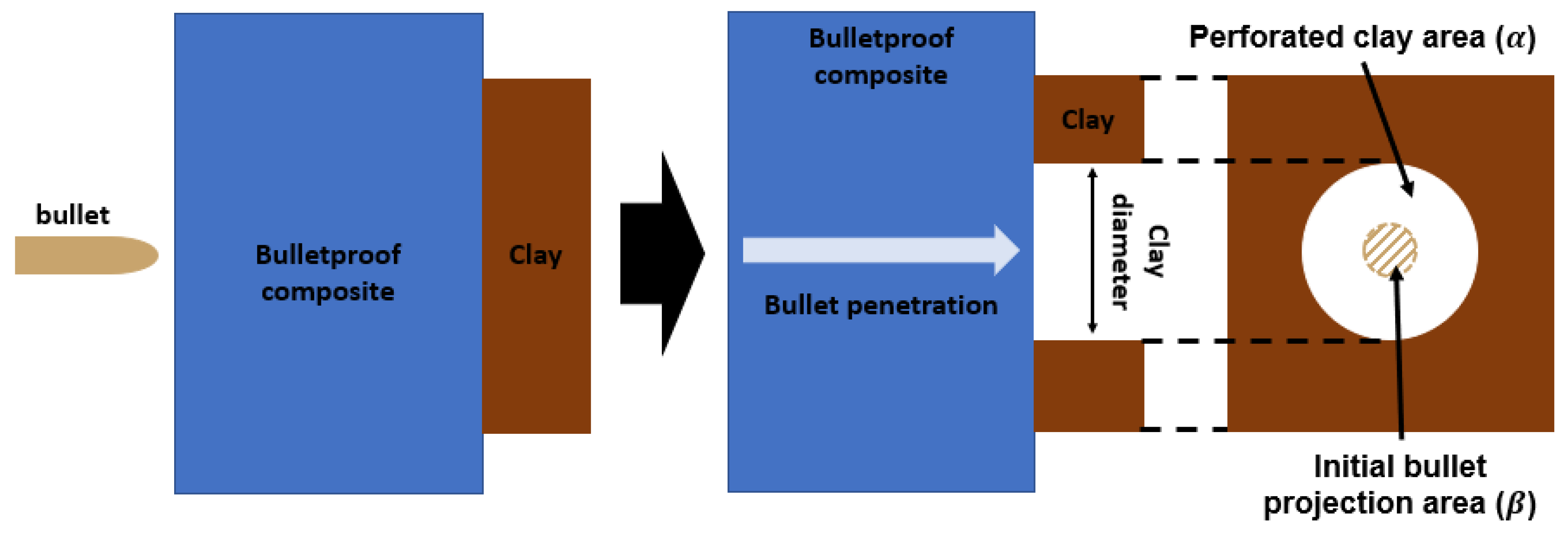
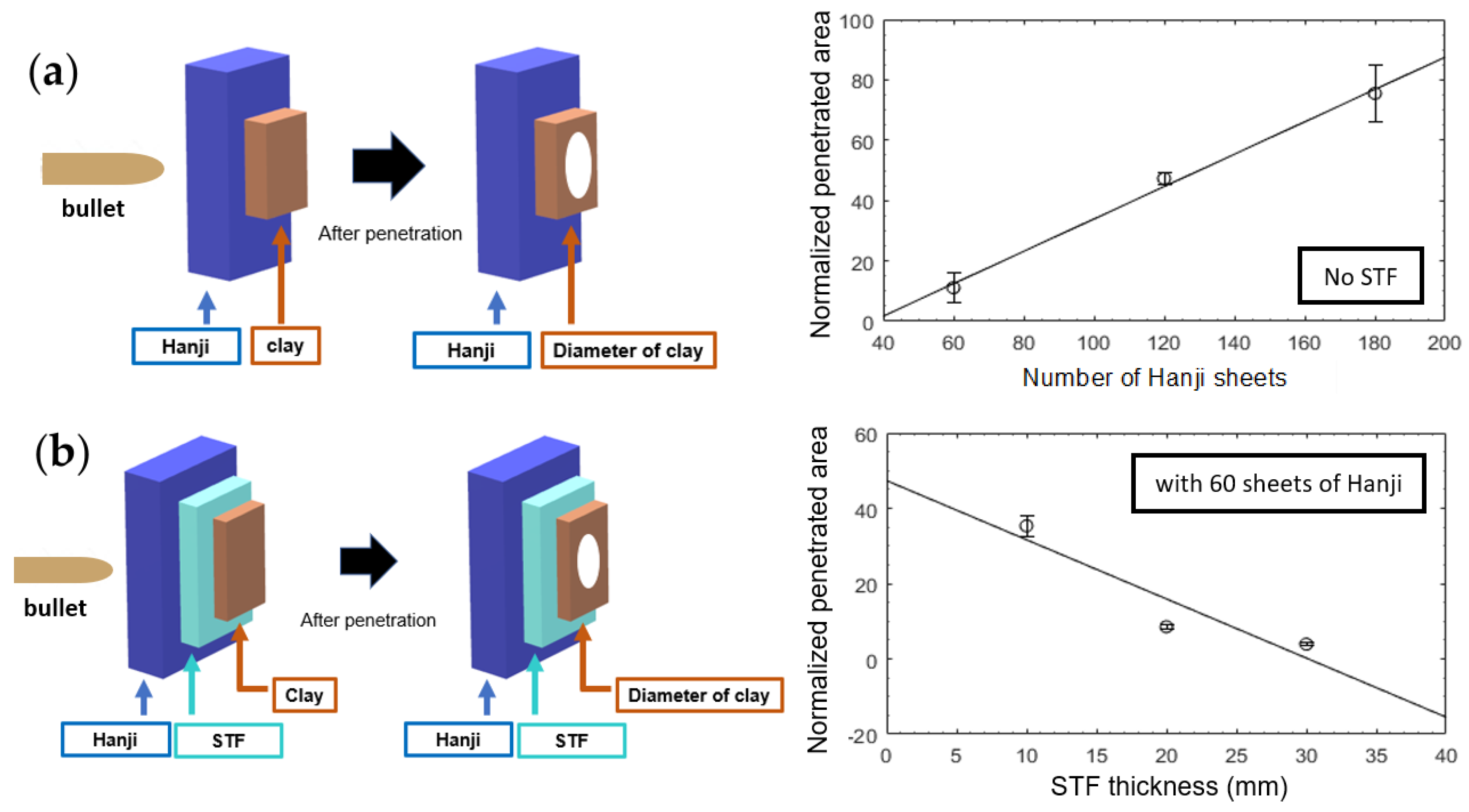
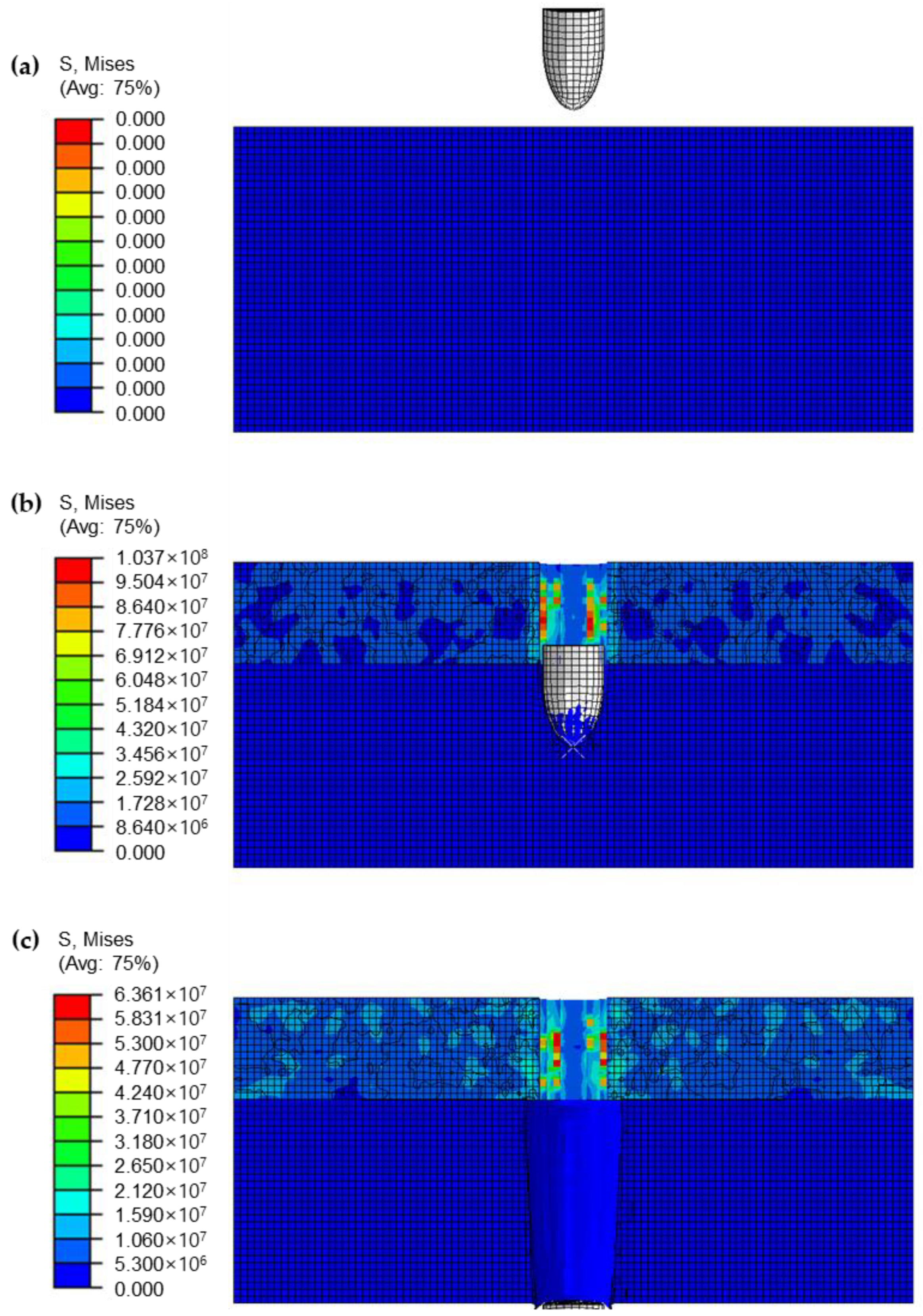
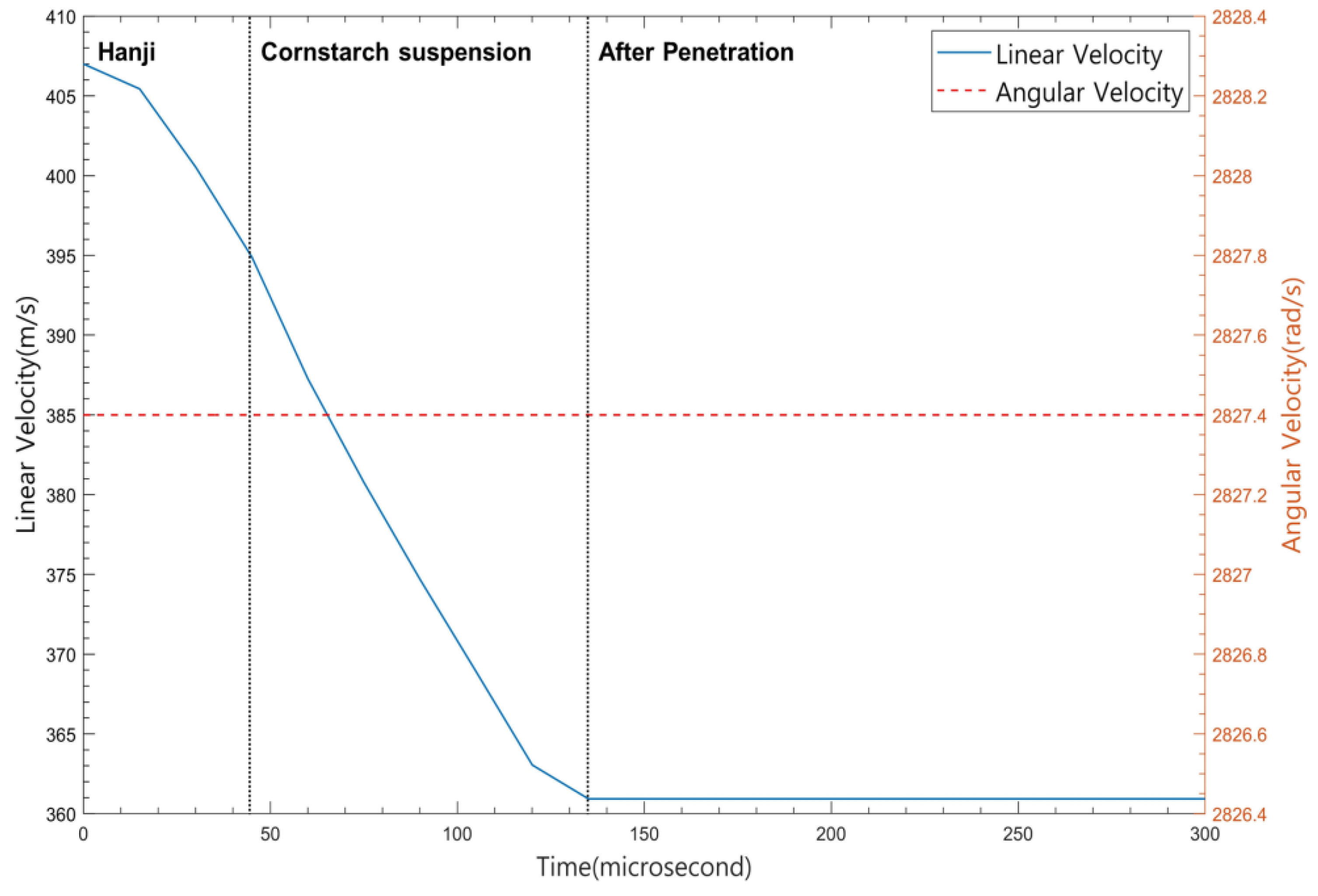
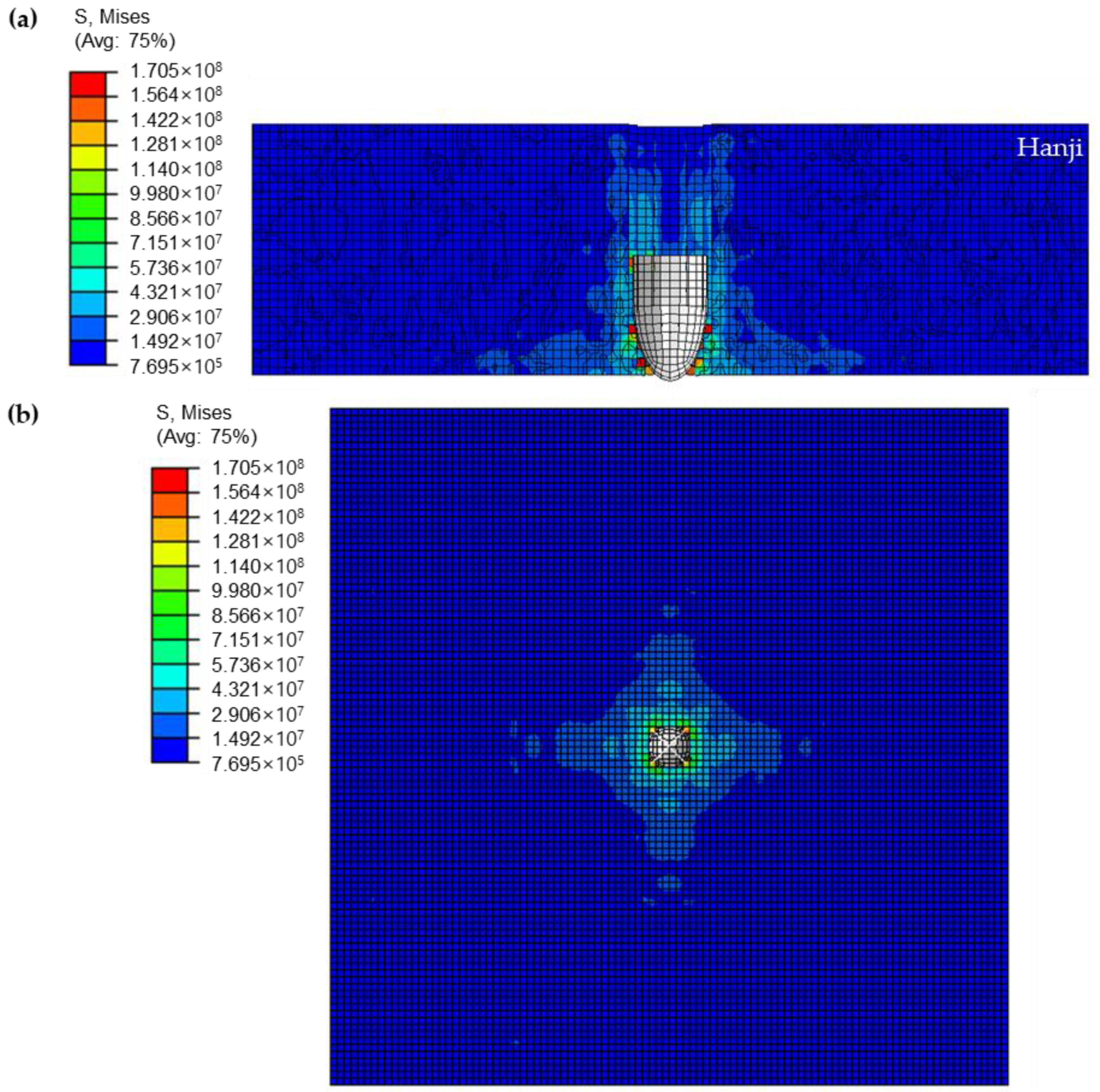
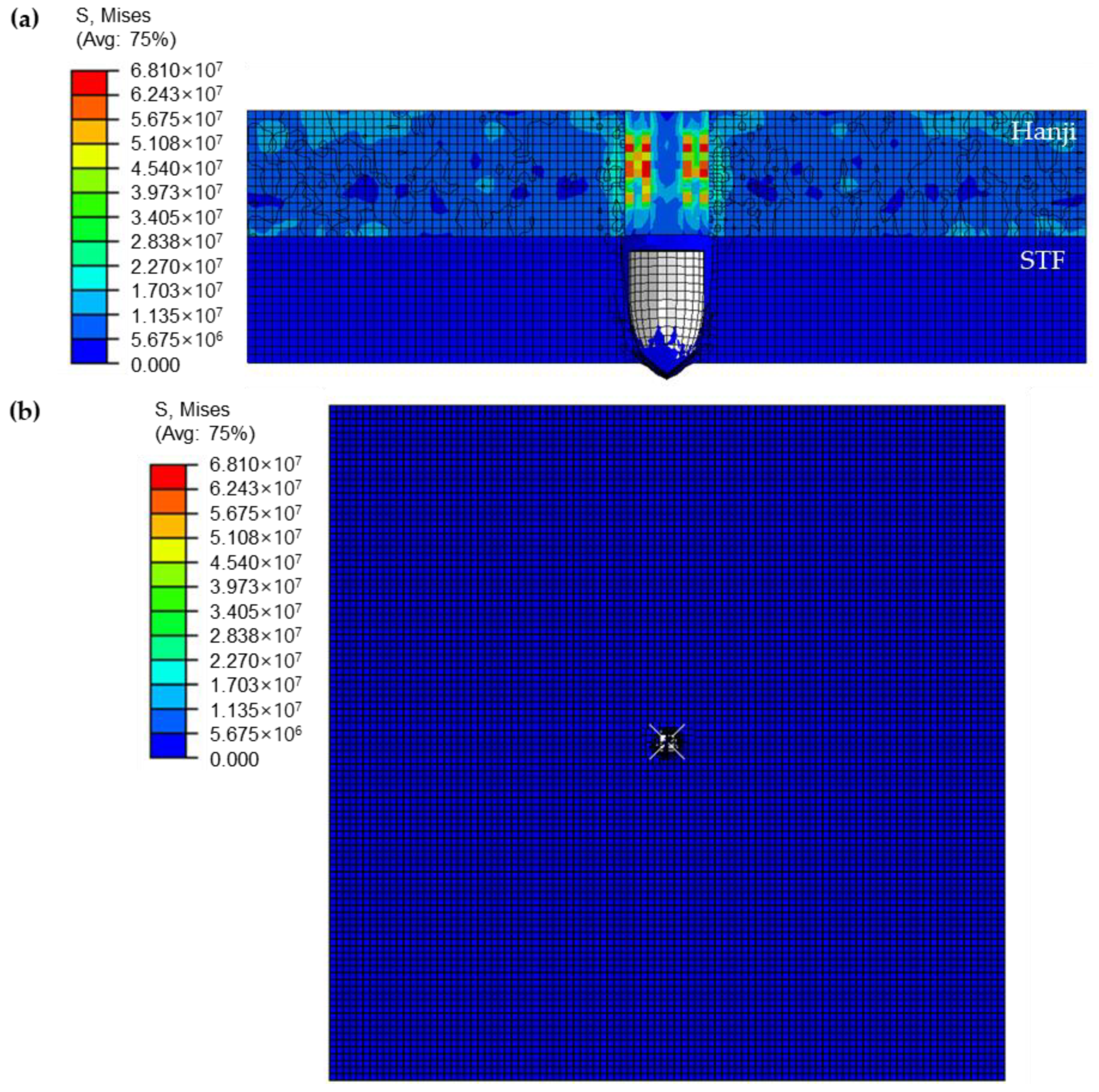
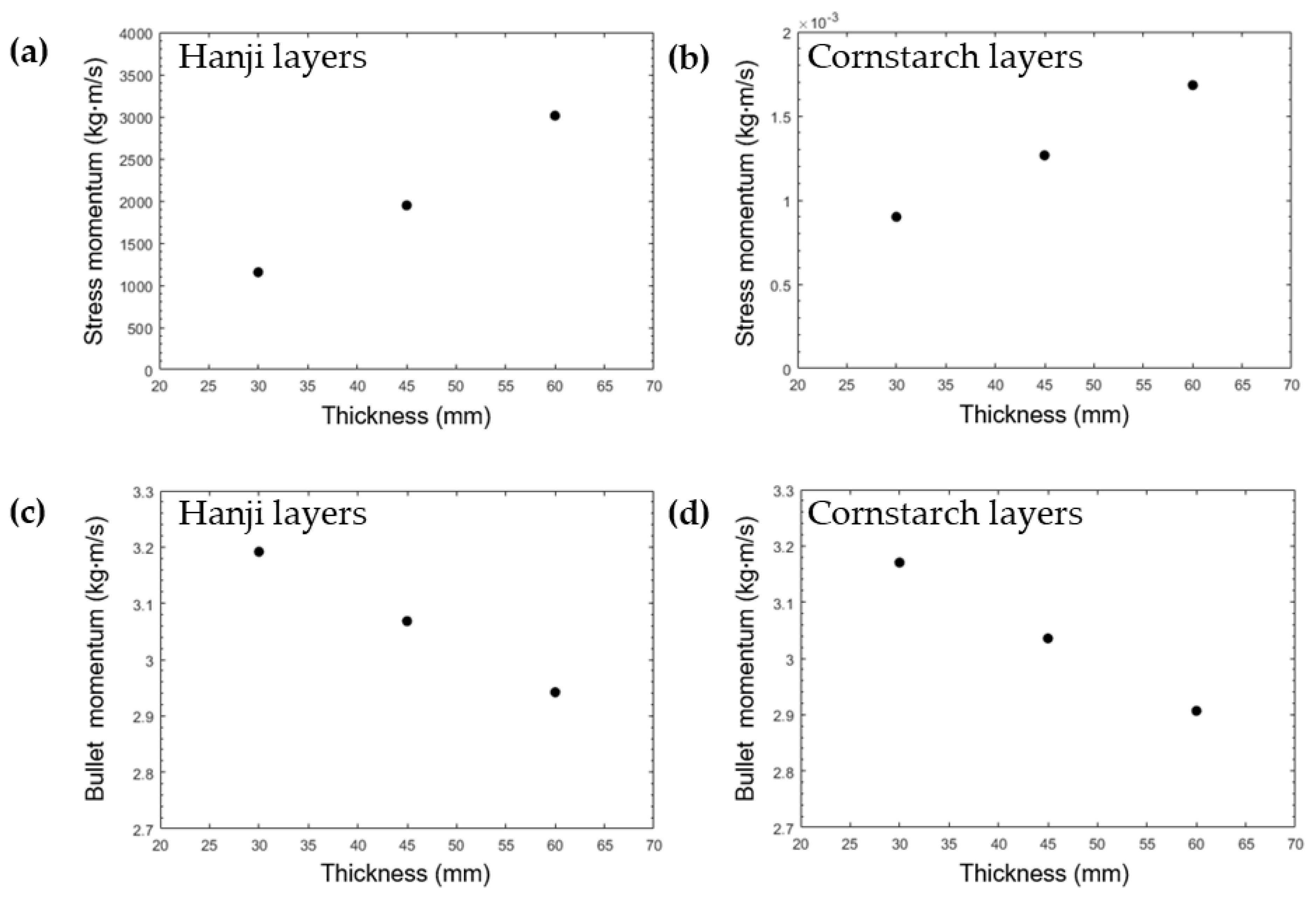
| Type | Thickness of Cornstarch Suspensions (mm) | Number of Hanji Sheets |
|---|---|---|
| A | 0 | 60 |
| B | 0 | 120 |
| C | 0 | 180 |
| D | 10 | 60 |
| E | 20 | 60 |
| F | 30 | 60 |
| Hanji thickness (mm) | STF thickness (mm) | Linear Velocity (m/s) |
|---|---|---|
| 20 | 35 | 351.167 |
| 20 | 25 | 361.294 |
| 15 | 37.07 | 353.632 |
| 22.07 | 30 | 354.282 |
| 15 | 30 | 360.928 |
| 15 | 22.93 | 367.92 |
| 7.93 | 30 | 367.304 |
| 10 | 35 | 360.435 |
| 10 | 25 | 370.684 |
© 2019 by the authors. Licensee MDPI, Basel, Switzerland. This article is an open access article distributed under the terms and conditions of the Creative Commons Attribution (CC BY) license (http://creativecommons.org/licenses/by/4.0/).
Share and Cite
Cho, H.; Lee, J.; Hong, S.; Kim, S. Bulletproof Performance of Composite Plate Fabricated Using Shear Thickening Fluid and Natural Fiber Paper. Appl. Sci. 2020, 10, 88. https://doi.org/10.3390/app10010088
Cho H, Lee J, Hong S, Kim S. Bulletproof Performance of Composite Plate Fabricated Using Shear Thickening Fluid and Natural Fiber Paper. Applied Sciences. 2020; 10(1):88. https://doi.org/10.3390/app10010088
Chicago/Turabian StyleCho, Hyeonho, Jongsuk Lee, Sungjin Hong, and Sunghan Kim. 2020. "Bulletproof Performance of Composite Plate Fabricated Using Shear Thickening Fluid and Natural Fiber Paper" Applied Sciences 10, no. 1: 88. https://doi.org/10.3390/app10010088
APA StyleCho, H., Lee, J., Hong, S., & Kim, S. (2020). Bulletproof Performance of Composite Plate Fabricated Using Shear Thickening Fluid and Natural Fiber Paper. Applied Sciences, 10(1), 88. https://doi.org/10.3390/app10010088






